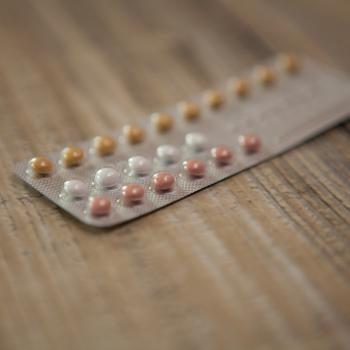My viral post, How I Lost Faith in the Pro-Life Movement, is still generating regular new comments. Just the other week I got this line, for instance:
The only birth control that’s 100% effective? Abstinence.
This is something I’ve run into a lot, and something I used to think myself. But it’s wrong—and on several levels.
First off, abstinence is not a birth control method. Let’s start with an analogy. Imagine if you asked your friend told your friend you were going to be doing some gardening outside in the next week and asked her what kind of sunscreen she recommended for avoiding sunburn, and she recommended that you just stay inside. Sure, staying inside would mean avoiding a sunburn, but that’s not the point. If you weren’t planning to go outside, you wouldn’t have asked for sunscreen recommendations because you wouldn’t need sunscreen.The question was what kind of sunscreen is best for avoiding a sunburn when going outside, and “staying inside” is not a sunscreen brand.
I could give lots of other analogies—for example, calling abstinence birth control is like calling bald a hair color—but you get the point. Birth control methods are ways of preventing pregnancy in sexually active women. If you’re not sexually active, you don’t need birth control, because you can’t get pregnant (except as a result of rape, of course). Look, if abstinence was a method of birth control it would be something that married women could use too. Yes, there’s NFP, which involves periodic abstinence, but that method actually involves being sexually active and is therefore not the same thing people mean when they promote abstinence-only sex education, call abstinence a method of birth control, or say “if you don’t want a baby, don’t have sex.” The simple reality is that abstinence is not something sexually active women use to avoid pregnancy. Instead, it’s about not being sexually active in the first place, and it’s therefore not birth control.
But let’s look at abstinence for a moment as though it were a birth control method. If we were to label abstinence as birth control, would it actually be “the only birth control method that’s 100% effective”?
The first thing to understand is that when measuring the effectiveness of various methods of birth control, researchers use two different rates: perfect use and typical use. Perfect use number shows the rate of effectiveness when the method is used perfectly (i.e., there are no missed pills, no condoms skipped in the heat of the moment, etc.). Typical use shows the rate of effectiveness as the methods are typically used, accounting for user error (i.e., missed pills, condoms skipped in the heat of the moment, etc.). As a result, if we want to actually examine abstinence used as a method of birth control (which again, it is not), we will need to look at its perfect use rate and typical use rate separately.
Perfect Use
For a woman using abstinence as a method of birth control, perfect use would mean not giving in to biological urges or social pressures and having sex; perfect use would mean always saying “no”—i.e., using abstinence correctly. But the perfect use rate for abstinence is actually not 100%. A woman could “use the method” perfectly, i.e. never consent to sex, and yet become pregnant as a result of rape. And remember that the majority of rape is committed by someone a woman knows, often an intimate partner or a date. In the case of rape, women’s ability to say “no” and remain abstinent is taken from them. Bearing this in mind when talking about the perfect use rate of abstinence is incredibly important, because a woman using abstinence to avoid pregnancy can do everything “right” and yet still end up pregnant due to circumstances outside of her control. I am going to sketch a quick outline of how the perfect use rate for abstinence could be determined, but I want to be clear that I’m using a lot of numbers that are estimates here. Please let me know if you have better numbers for any of this.
First we need to determine the number of women who are raped each year. We’re going to stick with the U.S. here (be aware that the perfect use failure rate of abstinence in, say, the Congo would be far far higher). Estimates of the number of women raped in the U.S. each year range from 64,080 to 300,000 to 683,000. What we are looking for here is specifically vaginal rape perpetrated against women of child bearing age. For the purpose of this experiment, I’m going to choose a number somewhat arbitrarily. We’re going to go with the middle number and say that 300,000 women raped each year, and we’re going say that that all of these are of child bearing age and all of these rapes are vaginal. There are roughly 70,000,000 women of child bearing age in the United States. If 300,000 of these 70,000,000 women of raped each year, each woman of child bearing age has a 0.43% chance of being raped in a given year.
Next we need to determine how many of these rapes will result in pregnancy. Remember that, for the sake of our calculations, each of these rapes is vaginal. Now, a woman who is raped generally has a 5% chance of getting pregnant from that rape, but that number is lower than the number we will use because many of those women are on the pill or use some other hormonal method of birth control, thus lowering their risk of pregnancy. A woman is generally capable of getting pregnant during a six day window each cycle, and the average cycle is 28 days. This would suggest that a woman not using birth control would have right about a 20% chance of getting pregnant from a given vaginal rape. However, this ignores the fact that women’s fertility varies, and that some women can try for months before getting pregnant. Plugging in both the 5% number and the 20% number and multiplying each by the 0.43% chance of being raped, we find that a given woman using abstinence as birth control will have something between a 0.02% and a 0.09% chance of becoming pregnant each year. I’m going to go with a number in between the two but closer to the higher number: 0.07%.
Based on this back-of-the-napkin outline, we find that the perfect use rate of abstinence is not 100% but rather 99.93%. This remains a very high number, of course. By way of comparison, the perfect use effectiveness rate for the condom is 98.0%; for the pill is 99.7%, for the Mirena IUD is 99.8%; and for the implant is 99.95%. This means that looking at perfect use rates, abstinence is among the most effective forms of birth control, but is not the most effective form, and doesn’t beat its nearest contenders by much.
The Typical Use Effectiveness Rate
Next we need to calculate the typical use rate for abstinence. A typical use rate is calculated by looking at what methods of birth control women say they are using and then looking at how many of them end up pregnant. Whenever a birth control method allows for a measure of human error, the typical use will differ from the perfect use. People miss pills, they skip condoms in the heat of the moment, they’re, well, human and therefore prone to human error. This makes the typical use rate extremely important. While a woman on the pill may have only a 0.7% chance of becoming pregnant in a given year if she uses the pill perfectly, because most women do not use it perfectly the average woman using the pill actually has a 9.0% chance of becoming pregnant in a given year. The condom has a similar gap between its perfect use and typical use rates. The IUD and the implant, in contrast, do not have any difference between perfect use and typical use because they are not subject to user error.
When it comes to abstinence, the typical use rate is going to be lower than the perfect use rate because of the large number of people who say they are using abstinence—even going so far as to take formal abstinence pledges—and then end up having sex anyway before marriage anyway. Those who promote abstinence as birth control like to ignore this by arguing that those people should not be counted because they are no longer abstinent. The problem with that is that we still count people who miss pills or skip condoms when calculating the typical use rates for the pill and the condom. We don’t just dump them because they weren’t using their chosen method correctly. Fortunately, I don’t have to do the math for the typical use rate of abstinence myself. Heather Corinna of Scarleteen has already done it (also, this additional article touches on it). Let me quote from Heather:
The people promoting abstinence clearly haven’t wanted to study effectiveness and failure of abstinence as a method of contraception so we can all know what the typical use rates are. They want to frame it as contraception, which is already problematic, because contraception is defined as things we actively do or use to prevent pregnancy, not as things we don’t do or avoid using: contraceptive reference books won’t show rates for abstinence because people not having sex don’t need contraception. But if you’re going to put it out there as a method of birth control, you have to also treat it like one when it comes to the kind of study we have for all other methods. Alas.
For all the promotion of abstinence, we still don’t have studied, published typical use rates for abstinence as a method: the rate that shows us, for every method of contraception, how frequently a method does and doesn’t result in pregnancy when used by people in daily life.
But that doesn’t mean we can’t get a good idea of what that rate is ourselves. This rate won’t be as sound as we could get with a specific study, but I think we can use plenty of data we have on abstinence, as well as on other methods and use of no method, to get a good idea of what typical use probably is.
. . .
Okay, then. Here’s sound and relevant data we can look at to help provide the answer to this burning question of typical use:
1) The typical (and perfect) use rate for using no method at all when having intercourse and/or other direct genital-to-genital contact between opposite-sexed and fertile people is 10 – 20%.(AHRP, FWHC, Contraceptive Technology)
2) The typical use rate for using natural family planning without another method as a backup, which includes abstaining from direct genital-to-genital contact and intercourse during fertile times as well as tracking fertility in at least one of several ways, is 75 – 80% (Merck, AHRP, FWHC, Contraceptive Technology).
. . .
5) Studies which have been done about those who pledge abstinence have found that those who pledge abstinence do not have intercourse at lower rates than those who do not pledge, nor do they have lower rates of pregnancy and STIs. Based on interviews with more than 20,000 young people who took virginity pledges, one study found that 88 percent of them broke their pledge and had sex before marriage (Brückner H, Bearman P. After the promise: the STD consequences of adolescent virginity pledges. Journal of Adolescent Health 2005; Bearman PS, Brückner H. Promising the future: virginity pledges and first intercourse. American Journal of Sociology 2001). Bearman did also find that in his study, those who pledged often delayed vaginal intercourse, some for even as long as as 18 months. Now, for those who do NOT have any kind of sex which poses a pregnancy risk (important, as “sex” in this case doesn’t include anal intercourse) for one full year, abstinence would be 100% effective. However, that’s not typical according to studies as a whole.
A study by Janet Elise Rosenbaum, PhD, AM (Patient Teenagers? A Comparison of the Sexual Behavior of Virginity Pledgers and Matched Nonpledgers, PEDIATRICS Vol. 123 No. 1 January 2009)found that teens who pledge to abstain from sex have just as much sex as those who don’t, and that those who pledge not to have sex until marriage don’t wait longer to have sex than those who don’t make that pledge. Pledgers did not differ in lifetime sexual partners and age of first sex. Fewer pledgers than matched nonpledgers also used birth control and condoms in the past year and birth control at last sex. She also found that five years after the pledge, 82% of pledgers denied having ever pledged at all. Central to the information we’re looking for, on typical use in a year, “pledgers reported an average of 1.09 past-year vaginal sex partners, 0.11 fewer than nonpledgers.” In other words, on average, those who report using abstinence are not using abstinence perfectly each year.
Rosembaum’s study was fantastically done, by the way, with a far sounder and stricter methodology than the Bearman and Brückner studies. She even ensured, via 128 different factors, that her samples of those who pledged and those who didn’t had similar attitudes towards sexual activity to begin with.
Lastly, of the ten studies identified by the Heritage Foundation as providing proof that their respective programs reduced early sexual activity, nine of them failed to provide credible evidence that they delayed the initiation of sex or reduced the frequency of sex (“Do Abstinence-Only Programs Delay the Initiation of Sex Among Young People and Reduce Teen Pregnancy?,” Douglas Kirby, Ph.D, The National Campaign to Prevent Teen Pregnancy).
. . .
At first glance, the rates for natural family planning/periodic abstinence may look plausible as the typical use rate for abstinence. However, FAM/NFP is a method all by itself of which abstinence is only one part. Someone who was using abstinence as a sole method isn’t using NFP/FAM: if they’re not doing any kind of fertility awareness, they’re only using abstinence. If they are doing any kind of fertility awareness, they’re using NFP/FAM, not abstinence. Using NFP and FAM, includes, and is centered around calculating fertility in some way: either by the calendar method, or more efficiently, with daily tracking of cervical mucus and/or basal temperatures, then fertility predictions based on charting one or both over time. That’s not part of how abstinence is defined.
However, in that method there is a shared motivation to those using abstinence, which is the motivation to abstain from sex, even though it’s not a constant. I don’t think that typical use rate is irrelevant, because motivation isn’t irrelevant in typical use, and NFP rates do give us some information on abstinence: but it’s also only part of the picture.
Given the study we have on abstinence shows us the amount of sex and lifetime partners had appears to be no less than those who don’t report using abstinence as a method, we can presume that when it comes to figuring out the typical use rates, we’re not considering a group of people whose sex lives — when it comes to having sex, and to frequency of sex — are that different than we’d find when considering any other group. In other words, if someone who is using abstinence doesn’t use it perfectly, but typically, meaning they did not abstain from sex or the kinds of sex which have the potential to create a pregnancy, and we are ONLY considering abstinence as a sole method, not other methods they may use (which would then be about rates for combining methods), then they may be the same, practically speaking, as those who do not use any method at all.
It may be sound and accurate to state that the typical use rate for abstinence as a sole method is probably the same as the typical use rate for no method: 10-20%. However, I’m not willing to dismiss that intention of use, and motivation to use, is a factor in the use of any method, including abstinence. I also can’t dismiss that rates for NFP, while they involve a built-in backup method abstinence alone does not, do also take some abstinence into account. Using abstinence sometimes in a year, but not all the time or for the whole of a year, is consistent with the studies we have on abstinence, and what I hear from young people who have been using it as a method or taken a pledge.
My theory is that the typical use rate for abstinence is the average of the typical use rate for using no method at all, and the typical use rate for periodic abstinence, which lands us at a rate of 42.5-50%. I may be overly generous in that estimate, but I don’t think so. If you think I am, and want to play it as safe as possible, then you’ll want to consider it to be the 10-20% figure, instead. (I’d also be really interested in reading your own comments on this, and seeing your own theories.)
Even with that potentially generous estimate of 42.5 – 50%, abstinence has the lowest effectiveness rate in typical use of all methods. That’s important information for people considering any method to have, especially if this method is touted as being foolproof by someone who says condoms, with around an 85% typical use rate, are said to never or only infrequently be effective.
In order to have an exact number, let’s average 42.5% and 50%. This leaves us with 46.3% as the typical use rate for abstinence. This is a very very bad typical use rate. In fact, it’s a worse typical use failure rate than any other method of birth control out there. The typical use rate for the pill is 91%, and for the condom is 82%. The Mirena IUD and the implant have the same typical use rate as their perfect use rate—99.8% and 99.95%—because they are not subject to user error. Given that people who say they will be abstinent typically don’t, and that abstinence-only sex education does not prevent people from having premarital sex (at best it delays first intercourse a short period, but also makes people more likely to engage in risky sex when they do have intercourse), abstinence’s typical use rate puts it at the very bottom when it comes to effectiveness as a method of birth control.
Conclusion
Next time someone tells you that people should just use abstinence as a method of birth control, and that abstinence is actually the most effective method of birth control—100%!—you might want to point out that abstinence is not birth control, and then discuss the difference between perfect use and typical use in determining the effectiveness rates of birth control, and the importance of factoring in the chance of sex without consent. From my experience at least, this argument is seen in pro-life circles as a “gotcha” argument, and we really need to be pushing back by pulling back the curtain.
Even if a pro-lifer refuses to accept the point regarding the typical use rate of abstinence, explaining the difference between perfect and typical use rates will help combat misinformation. Generally, those promoting abstinence as birth control point to the typical use rate of things like the pill and the condom, ignoring the high typical use rates of the IUD and the implant and refusing to consider that their own method might require perfect use or incur disaster. Comparing perfect use abstinence with typical use of the pill and the condom is highly unfair and disingenuous.
Finally, if someone is so very concerned about the typical use rate of pills and condoms and so very enamored with the supposed effectiveness of abstinence, they really ought to be ready to at least send a nod in the direction of the IUD and the implant, which maintain their high effectiveness rate even in typical use and have the potential to drastically decrease the number of unplanned pregnancies. But then, when it comes down to it I suspect the “abstinence is the most effective method of birth control” people are actually more interested in preventing premarital sex than they are in helping women control when and whether to become pregnant.














